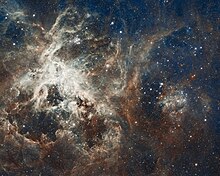Ӳкерчĕк:30 Doradus, Tarantula Nebula.jpg

Ҫак умкурӑмӑн виҫи: 749 × 599 пиксел. Ытти разрешенисем: 300 × 240 пиксел | 600 × 480 пиксел | 960 × 768 пиксел | 1280 × 1024 пиксел | 2560 × 2048 пиксел | 20 323 × 16 259 пиксел.
Оригиналлӑ файл ((20 323 × 16 259 пиксел, файл пысăкăше: 99,35 Мб, MIME-тĕсĕ: image/jpeg))
Файл историйĕ
Вӑхӑт ҫине пуссан, ун чухнехи версине пӑхма пулать.
| Дата/Вăхăт | Миниатюра | Калӑпӑш | Хутшăнакан | Асăрхав | |
|---|---|---|---|---|---|
| хальхи | 18:35, 8 Утӑ уйӑхӗн 2012 |  | 20 323 × 16 259 (99,35 Мб) | Prof. Professorson | Higher resolution, converted from http://spacetelescope.org/static/archives/images/original/heic1206a.tif. |
| 12:13, 19 Ака уйӑхӗн 2012 |  | 2340 × 1847 (2,52 Мб) | Dipankan001 |
Файлпа усă курни
Ку файлпа ҫак 1 страницӑра усӑ курнӑ:
Файлпа глобаллӑ усӑ курасси
Ку файлпа ҫак викисенче усӑ курнӑ:
- af.wikipedia.org усӑ курасси
- ar.wikipedia.org усӑ курасси
- be-tarask.wikipedia.org усӑ курасси
- bn.wikipedia.org усӑ курасси
- crh.wikipedia.org усӑ курасси
- cs.wikipedia.org усӑ курасси
- de.wikipedia.org усӑ курасси
- en.wikipedia.org усӑ курасси
- Starburst region
- Wikipedia:WikiProject Astronomy/Recognized content
- Wikipedia:Featured pictures/Space/Looking out
- Wikipedia:Teahouse/Guests
- Wikipedia:Teahouse/Guest profile summary
- Wikipedia:Teahouse/Guest profile summary/Avatars
- Wikipedia:Teahouse/Guests/Left column
- Wikipedia:Teahouse/Guests/Right column
- User:The Determinator/Userpage/Top/Image
- Wikipedia:WikiProject Astronomy/Recognized astronomy content
- Wikipedia:Teahouse/Guest/Featured/21
- Wikipedia:Teahouse/Guest/Featured/22
- Wikipedia:Teahouse/Guest book/Archive 13
- Wikipedia:Teahouse/Guest book/Archive 14
- Wikipedia:Teahouse/Guest book/Archive 15
- Wikipedia:Teahouse/Guest book/Archive 16
- Wikipedia:Teahouse/Guest book/Archive 17
- Wikipedia:Teahouse/Guest book/Archive 18
- Wikipedia:Teahouse/Guest book/Archive 19
- Wikipedia:Teahouse/Guest book/Archive 20
- Wikipedia:Teahouse/Guest book/Archive 22
- Wikipedia:Teahouse/Guest book/Archive 23
- Wikipedia:Teahouse/Guest book/Archive 24
- Wikipedia:Teahouse/Guest book/Archive 26
- Wikipedia:Teahouse/Guest book/Archive 28
- Wikipedia:Teahouse/Guest book/Archive 29
- Wikipedia:Teahouse/Guest book/Archive 30
- Wikipedia:Teahouse/Guest book/Archive 31
- Wikipedia:Teahouse/Guest book/Archive 32
- Wikipedia:Teahouse/Guest book/Archive 34
- Wikipedia:Teahouse/Guest book/Archive 35
- Wikipedia:Teahouse/Guest book/Archive 36
- Wikipedia:Teahouse/Guest book/Archive 37
- Wikipedia:Teahouse/Guest book/Archive 39
- Wikipedia:Teahouse/Guest book/Archive 40
- User:LucasTichawa
- Wikipedia:Teahouse/Guest book/Archive 42
- Wikipedia:Teahouse/Guest book/Archive 43
- Wikipedia:Teahouse/Guest book/Archive 44
- Wikipedia:Teahouse/Guest book/Archive 45
- Wikipedia:Teahouse/Guest book/Archive 0
- Wikipedia:Teahouse/Guest book/Archive 47
Ку файлпа глобальлӗ епле усӑ курнине пӑх.



